June 15, 2007
Air Date: June 15, 2007
FULL SHOW
SEGMENTS
Plugging into the Energy Debate
/ Jeff YoungView the page for this story
The U.S. Senate is debating an energy bill that could bring more fuel efficient vehicles, boost alternative energy, and reduce oil consumption. But some amendments to the bill would go the other direction, giving automakers a pass and encouraging coal and offshore drilling. Living on Earth's Washington correspondent Jeff Young plugs us in to the energy debate. (06:00)
Home Wind
View the page for this story
A piece of legislation sitting before the House Committee of Ways and Means would give homeowners a tax break for setting up a small wind-turbine in their backyard. But, in an effort to boost renewable energy, some states have already started to underwrite the costs of residential wind turbines. Living on Earth's Steve Curwood speaks to a home wind operator about her turbine in San Bernardino, CA. (05:45)
EPA Chemical Testing
View the page for this story
The EPA announced that it will begin testing pesticides for human toxicity. But how do you test the 80,000 chemicals currently on the market in a timely and safe manner? Host Steve Curwood talks with Gina Solomon, senior scientist with Natural Resources Defense Council, about how the EPA might follow through on its testing commitment. (07:00)
Vida Verde
/ Catherine EltonView the page for this story
Professional housecleaners are frequently exposed to hazardous cleaning products and have a higher incidence of asthma compared to other workers. In the Boston area, a group of Brazilian immigrant housecleaners have joined together to form a co-op that makes their own environmentally-friendly and safe cleaning products. Catherine Elton reports. (07:00)
Hung up on Hangers
View the page for this story
If Bob Kantor of HangerNetwork has his way, the wire hanger will soon be an item of the past. Kantor’s company produces recyclable cardboard hangers, which are being distributed by more than 30,000 drycleaners across the country. He talks with host Steve Curwood about his businees. (03:00)
Colorado Plateau Drilling Plan
/ Ingrid LobetView the page for this story
A stretch of Colorado high plateau, prized by recreationists, may soon be open to gas drilling. The gas industry says Congress intended the oil and gas-rich Roan Plateau to be drilled. But many Colorado residents, and some elected officials, want the federal plan reviewed. Living on Earth’s Ingrid Lobet reports. (04:30)
A Whale of a Sliver
View the page for this story
An old harpoon tip was discovered lodged in the body of a whale recently killed by Eskimo hunters in the Arctic Ocean. Historians date the weapon to be roughly from 1890, which means the bowhead whale was at least 125 years old when it was killed. (02:30)
Blessedly Unrestful
View the page for this story
Author, activist and businessman Paul Hawken talks to Living on Earth's Steve Curwood about his new book, "Blessed Unrest." In the book, Hawken looks at how the social justice and environmental movements developed over the past two hundred years and how they have changed the way that governments and businesses act toward people and the Earth. (09:20)
Show Credits and Funders
Show Transcript
HOST: Steve Curwood
GUEST: Denise Cooley, Dr. Gina Solomon, Bob Kantor, John Bockstoce, Paul Hawken
REPORTERS: Jeff Young, Catherine Elton, Ingrid Lobet
[THEME]
CURWOOD: From Public Radio International - this is Living on Earth.
[THEME]
CURWOOD: I’m Steve Curwood. For the first time, the new Democratic majority on Capitol Hill is shaping comprehensive energy legislation. A Senate bill would boost conservation and renewables.
REID: Altogether our bill will cut our oil consumption by more than four million barrels a day and reduce our dependence on foreign energy sources right away. And, by the way, we might just save the planet while we’re at it.
CURWOOD: Also, Eskimo whale hunters kill an ancient whale---and find a harpoon fragment that was imbedded for more than a 100 years.
BOCKSTOCE: It’s a piece of brass about 3-1/2 to four inches long. We examined the piece and found that it was a model made after a patent of 1879, which is only made from 1879 to 1885, we think.
CURWOOD: We’ll have those stories and more this week on Living on Earth.
Stick around!
[THEME MUSIC UP AND OUT]
[NPR NEWSCAST]
ANNOUNCER: Support for Living on Earth comes from the National Science Foundation and Stonyfield Farm.
Plugging into the Energy Debate
CURWOOD: From the Jennifer and Ted Stanley Studios in Somerville, Massachusetts, this is Living on Earth. I’m Steve Curwood.
Democratic leaders on Capitol Hill say they want the country to move forward with energy that is clean and green. A bill on the Senate side would increase funding and incentives for alternative fuels and renewable energy. It would also set new efficiency standards for lighting and appliances and require that cars and trucks get more miles per gallon. Democratic Senate leader Harry Reid.
REID: Altogether our bill will save American consumers tens of billions of dollars annually, cut our oil consumption by more than four million barrels a day and reduce our dependence on foreign energy sources right away. And, by the way, we might just save the planet while we’re at it.
CURWOOD: But some senators from both parties would also like to see the expanded use of coal, and take a conservative approach for setting new fuel economy standards. Our Washington correspondent Jeff Young joins us now to take a look down the country’s energy path. Hi, Jeff!
YOUNG: Hi, Steve.
CURWOOD: Jeff, Senator Reid says this bill would cut U.S. oil consumption. How would it do that?
YOUNG: It would change both the country’s fuels and its vehicles. This bill pumps up production of biofuels to 36 billion gallons within 15 years, that’s five times the current level. And it says all the cars and trucks that a company makes should average 35 miles a gallon by the year 2020. That’s up from today’s average, which is about 25.
CURWOOD: And does the Senate majority leader have the votes for that?
YOUNG: The first of those goals is a political slam-dunk. Everybody here loves biofuels—let’s grow our energy in the Midwest instead of buying it from the Middle East—that sort of thing you hear a lot of. The second part, though, about changing the vehicles, that’s a tough fight.
CURWOOD: Detroit does seem to be very good at telling Washington to leave it alone. How will automakers fare this time?
YOUNG: Well, Detroit is saying they can’t meet that 35 miles per gallon standard. And Michigan’s Democratic Senators, Carl Levin and Debbie Stabenow, are working hard to lower the bill’s mileage standards. But there’s a strong sense here on the Hill that automakers have to do something. You know the average fuel economy for cars and trucks in ’07 is lower than it was in 1987. And you can just hear the frustration from senators like California Democrat Diane Feinstein.
FEINSTEIN: The fact of the matter is that Detroit has done nothing about mileage efficiency for the past 20 years and the time has come.
CURWOOD: Jeff, I know ethanol and biofuels are getting a lot of support, but what about this plan that you reported on recently to use coal, liquid coal, to power our cars?
YOUNG: That is another big fight that is brewing here. A lot of coal state Senators, including a lot of Democrats by the way, they say, hey, if we really want to be energy independent, well, we are the Saudi Arabia of coal, and we could turn it into a liquid transportation fuel. They want some help from Congress, maybe having the military buy the fuel at first, to sort of jump-start a liquid coal industry and voila, solve our oil problem.
CURWOOD: Yeah, but what about the environmental climate change problem and those costs of coal?
YOUNG: Oh yeah, that. Well, there is stiff opposition to this liquid coal proposal. One, it turns out it’s very expensive to turn coal into a liquid fuel. And two, unless you add even more expensive equipment to the process, it would put out about twice the greenhouse gases that gasoline does. So environmental groups are fighting this. For example, Senator Barack Obama of Illinois, he originally supported liquid coal. He took a lot of heat from environmental groups and had to back away from it recently. It does, however, appear that a compromise of some sort is in the works for this bill that would support liquid coal but require that those projects capture the carbon dioxide they produce—of course, that’s the major greenhouse gas.
CURWOOD: And, Jeff, what about the greenhouse gases coming from all that coal we burn for electricity, does the bill address that?
YOUNG: Well this is not, per se, a global warming bill—the Democratic leaders say they’re still working on that one. But this bill does have some of what you might call the building blocks of a global warming bill. And, probably the biggest is what’s called a renewable portfolio standard.
CURWOOD: Now renewables, you’re talking about things like wind, solar and biomass. What would this standard call for?
YOUNG: It says power companies have to produce 15 percent of their electricity from those clean sources you listed there. If they can’t, they’d have to buy credits from some other power company that does. New Mexico Democrat Jeff Bingaman chairs the Energy Committee, and he’s the one pushing this idea.
BINGAMAN: I think there are lots of different ways people can produce energy other than using fossil fuels. We’re trying to stimulate the technologies to use all of those.
YOUNG: Now some southern states that burn a lot of coal for their power and don’t have a lot of a lot of potential for wind power are fighting this. In fact, Republicans raised the possibility of a filibuster over this issue. But the idea has a lot of support in most of the country; 22 states already have some sort of renewable standard including, by the way, Texas, which has a lot of wind power and where the bill was signed by a fella named George Bush.
CURWOOD: So, Governor Bush signed such a measure. How about President Bush?
YOUNG: The president does not support this and he says he will veto this bill if it includes another provision under consideration that makes price gouging by oil companies a crime. And before we even get to that stage of things, of course we have yet to hear from the House of Representatives, they’ll probably take up energy next month.
But I’ve got to say, there is a remarkable amount of support for clean energy and efficiency that you just did not see on Capitol Hill until very recently. And I think that’s because there’s so much public anxiety about energy these days. We import too much oil, we’re warming the planet and we’re paying too much for gas. It’s sort of a trifecta of worry and Congress is really feeling the pressure to act.
CURWOOD: Jeff Young is Living on Earth’s Washington correspondent
Thanks so much, Jeff.
YOUNG: You’re welcome.
Related links:
- Union of Concerned Scientists
- Auto Alliance
- The Coal to Liquid Coalition
- NRDC: Why Coal is not a Viable Option
MUSIC: Kronos Quartet “Light A Match” from ‘You’ve Stolen My Heart’ (Nonesuch – 2005)
Home Wind
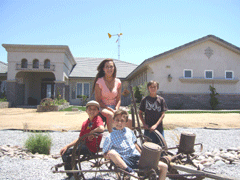
Denise Cooley lives on a Cajon Pass looking over the high desert in San Bernardino Valley. With her are her three sons (from left to right), Michael 11, Matthew 8, John 13. (Courtesy Denise Cooley)
CURWOOD: Among all the energy bills on Capitol Hill is a House measure that would provide tax breaks to homeowners who put small wind turbines in their backyards.
And it would follow the lead of some states, which already subsidize home wind power. One of these is California, where homeowner Denise Cooley has put up small wind turbines at each of two houses she owns in San Bernardino, east of Los Angeles, and she’s on the line. Ms. Cooley, tell me, how's the wind blowing out there today?
COOLEY: Today?
CURWOOD: Yeah.
COOLEY: Actually not that good.
[BOTH LAUGH]
COOLEY: There’s hardly any current at all. But that’s ok because there’s other days when it makes up for it.
CURWOOD: So, tell me what you can see out your window. I’m wondering if you can see the turbine.
COOLEY: Oh, yeah. It’s only about 50 feet from the house. My house now, I live on a ledge and I have the windmill up on the top portion. It’s the best location where I can get the best current. The higher up it is, the better consumption you can get.
CURWOOD: So, this is about a 10-kilowatt generator, I gather. And how much power do you get over the course of a year?
COOLEY: It typically ranges about 12 to 13 thousand kilowatts.

Denise Cooley's windmill is a 10kW Bergey Excel Turbine and stands 80 feet tall. (Photo: John Cooley)
COOLEY: Actually it’s about 100 percent. It balances out some months are slow and some months are excessive and so at the end of the year you look at it, and like last year I only had a 15 dollar bill and that was for being connected to the Edison grid.
CURWOOD: And before you had a wind turbine how much was your annual bill for electricity?
COOLEY: I don’t know annually. I know monthly, I would pay about 3 to 400 dollars a month in electrical alone.
CURWOOD: And what do you use in your house?
COOLEY: The house right now is around 4,000 square foot.
CURWOOD: 4,000 square feet! That’s a big house.
COOLEY: It is a big house and that’s what’s so nice about it, is that I’m able to generate enough wind current and enough kilowatt that the house will consume about the same amount and it levels out. It’s a wash.
CURWOOD: So, you have two wind turbines.
COOLEY: Well, I have the one on my first house that is for sale. And I have one on my current house. And as I was designing this house I made sure that I switched the water heaters over to electric and I put in as many ceiling fans as I could and then on the stovetop and different things that might have been propane, I could switch to electric.
CURWOOD: And, so far, the system that you put in your new house is covering everything that you need?
COOLEY: It covers everything. I still pay about $1.73 every month to be connected to the Edison grid and be able to enjoy this wonderful opportunity.
CURWOOD: So, a lot of people think about getting windmills. What motivated you to make the decision to actually do this?
COOLEY: Well, you look in your heart and you might have a toy, or car or a boat. And that might be about 25 thousand. And so the windmill, after the rebates, is the same price. So, we just projected out how long it would take to get that money back and then after that period you’re getting even more back so why not invest in your own home? They say your principle residence is the best investment you’ll ever make. So, knowing that and wanting to keep the costs down, and be conservative and just know that it’s the right decision.

Denise Cooley lives on a Cajon Pass looking over the high desert in San Bernardino Valley. With her are her three sons (from left to right), Michael 11, Matthew 8, John 13. (Courtesy of Denise Cooley)
COOLEY: Originally, the system was about 44 or 45 thousand. In the last couple years the prices and materials and everything have gone up. So, my first one I paid about 45, 50 percent of that. So it came to about 24 thousand. My second one I paid about 26, 27 thousand.
CURWOOD: Now, right now on Capitol Hill the federal government is looking at a bill that would give tax credits to folks who put up residential wind energy projects. Uh how much of a good or bad idea do you think this is?
COOLEY: Oh, no, it’s excellent. If it wasn’t for the rebates and it helping out with the majority of the costs then people wouldn’t be able to do it because they’re not going to be in that house for 20, 30 years to where they’re going to want to invest in that.
CURWOOD: Now, when you put up a wind turbine in a neighborhood, the neighbors might have objected. Did any of them object, and what did you say to them?
COOLEY: A couple would stop and they would pretend like they wanted to get educated and ask me questions about it. And then they would say, “oh we just wanted to stop and see how loud, and noisy, and annoying it was.” And so for them they just already had the mindset that they didn’t like it. And that was ok. But then I had other neighbors asking intelligent questions and wanting to see the inverter and watch my meter run backwards because they though that was impossible. You hear about it all the time but if you can see something with your own eyes it make more sense.
CURWOOD: Denise Cooley, thank you so much for taking this time with me today.
COOLEY: Thank you, I enjoyed it.
Related links:
- The American Wind Energy Association's small wind website
- U.S. Department of Energy handbook on purchasing small wind turbine
- Bergey Windpower
- Southwest Windpower
MUSIC: Kronos Quartet “Lover, Come To Me” from ‘You’ve Stolen My Heart’ (Nonesuch – 2005)
CURWOOD: Later in the program, the energy crunch stimulates drilling in the wilds of Colorado. That’s coming up on Living on Earth.
EPA Chemical Testing

Dr. Gina Solomon, senior scientist at the Natural Resources Defense Council. (Courtesy of Dr. Gina Solomon.)
CURWOOD: It’s Living on Earth. I’m Steve Curwood. We have two developments to tell you about this week on the topic of testing chemicals for toxic effects. In the first, the National Academy of Sciences is recommending that federal agencies like the EPA adopt sweeping changes to the ways that they test for health effects of chemicals. The goal is for these tests to be faster and cheaper, provide far more information, and be done with little or no use of laboratory animals.
In the second, related development, the EPA has just announced that it will finally begin testing 73 common pesticides for effects on the human hormonal, or endocrine system. This assessment of so-called hormone disruptors has been years in the waiting and finally came about in part because of a lawsuit filed by the Natural Resources Defense Council. Dr. Gina Solomon is a senior scientist with the NRDC, and she joins us now on a line from San Francisco. Dr. Solomon, can you tell us briefly what are the hormone disrupters and why we should be concerned about them?
SOLOMON: Hormone disrupters are chemicals that don’t belong in our bodies that interfere with the normal action of our hormones. These natural hormones guide infant development. They also guide many of our day-to-day life functions. So, messing with them is not a good idea.
CURWOOD: The Environmental Protection Agency has announced that they are going to start testing some 73 pesticides that people are most likely exposed to. How much of a victory is this for the public health community?
SOLOMON: One important point here is that EPA was required to start testing chemicals to see if they are endocrine disrupters eight or nine years ago. NRDC and other groups brought a lawsuit against EPA when it missed the first deadline required by Congress. EPA then, as part of the settlement of that lawsuit, agreed to start the testing process. They agreed to do that by 2002. They haven’t started yet, and they’ve only now announced a draft short list of chemicals that they’re thinking about testing. So, we’re a long ways from being able to say this is a step forward.
CURWOOD: Dr. Solomon, I want to turn now to another development in the news and you’re intimately involved with this. You’re on a panel at the National Academy of Sciences that’s looking at the whole question of testing for toxicity. Can you explain why it is that we need to look at this? What’s wrong with the way we test toxic chemicals today?
SOLOMON: The horrible delays with the EPA endocrine disrupter program are emblematic of where we stand with toxicity testing in general today. EPA is still struggling to get out of the last century. They’re very slow at getting new programs off the ground. Most of the chemical tests that are required are looking for crude end points such as death in a laboratory rat, obvious tumors, birth defects, or severe toxicity of internal organs. There are a lot more subtle ways and earlier markers of toxicity that we could be focusing on, but we’re not there quite yet. And the NAS panel is proposing moving in a much more upstream direction where we’ll find hints of toxicity far before it really occurs.

Dr. Gina Solomon, senior scientist at the Natural Resources Defense Council. (Courtesy of Dr. Gina Solomon.)
CURWOOD: Why would that be of help?
SOLOMON: The problems with toxicity testing today are that it costs a lot of money, takes a lot of effort to do even a small number of chemicals, and does not provide information about low-dose effects, effects of chemical mixtures. The new approach that the NAS is proposing would help deal with some of these problems by looking at pathways toward toxicity that can be tested just in cell systems in the laboratory.
CURWOOD: So, in other words, instead of looking for the flat tire, you’re looking for, maybe, a beginning of the erosion of the rubber?
SOLOMON: We would be looking for week spots in the rubber and spots where there might be a tiny hiss of air coming out. But we’re not waiting for the flat tire anymore.
CURWOOD: Now, as I understand it, these proposed methods of doing testing would perhaps take away the need to use animals. How would that happen?
SOLOMON: The NAS committee envisioned that some day, and it’s going to be many years in the future, there will be very little use of animals in toxicity testing. That’s because once we’re focusing on pathways we can actually get down to the cell level. And when we see that in cells a chemical is disrupting a pathway that can lead to say cancer, or birth defects, or neurological harm, we don’t need to know more. Once we know that that pathway is interfered with, then that chemical would need to be controlled to the point where it’s no longer interfering with that pathway.
CURWOOD: This sounds like a revolution for the field of toxicology, but if we’ve been testing chemicals more or less the same way since chemicals were introduced, I imagine it’s going to be, well it’s going to be kind of tough to change the whole culture and system of doing this. What are your expectations for the future of chemical testing?
SOLOMON: There’s already a revolution underway in chemical testing. There are organizations like the National Toxicology Program that are pioneering approaches that are just like the ones I’m describing. The next step of that revolution is to bring it into an arena where it can be useful for protecting public health and the environment.
CURWOOD: I take it you’re really excited about this prospect.
SOLOMON: I think that this proposal has a lot of merit in getting us out of some of the traps that we’re in right now, especially the toxic ignorance trap, where we know so little about so many chemicals. I also think that this promise is many, many years away, probably decades away. There’s a long road from here to there and I’m hoping that we can actually embark on that road and make these changes.
CURWOOD: Dr. Gina Solomon is a senior scientist with Natural Resources Defense Council and on the National Academy of Sciences Committee on Toxicity Testing and Assessment of Environmental Agents. Thank you so much.
SOLOMON: Thank you.
[MUSIC: Clogs “Medley (Excerpt)” from ‘Lantern’ (Brassland - 2007)]
CURWOOD: We asked the EPA about the lengthy delay in testing hormone-disrupting chemicals. Jim Gulliford, assistant administrator for the Office of Pesticides and Toxic Substances, did not reply directly. Instead he sent a written statement saying that the EPA is quote-- “a leader in endocrine disruptor research” and that the screening effort “will provide the agency with a more comprehensive assessment of a chemical's ability to affect the endocrine system."
Related links:
- Natural Resources Defense Council Website
- EPA Website
- EPA list of pesticide chemicals they plan to test
Vida Verde
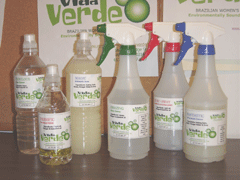
(Courtesy of Brazilian Women's Group)
CURWOOD: Every day millions of people in America, most of them women, expose themselves to dangerous chemicals in the home. That’s because many common household cleaning agents such as bleach, furniture polish, and toilet bowl and oven cleaners contain highly toxic substances. And for those who make their living cleaning houses, the rate of toxic exposure can be even higher. But there are safer cleaning chemicals. Now some immigrant housecleaners in the Boston area have joined forces to try to cut their exposure by greening the way they clean. Catherine Elton has our story.
[SOUND OF WOMEN SPEAKING IN PORTUGESE]
ELTON: In the basement office of the community organization the Brazilian Women’s Group, several Brazilian housecleaners sit around tables and discuss the agenda for an upcoming meeting. The women are part of Vida Verde, a new green cleaning cooperative that began last December.
Monica Chianelli, a housecleaner and the coop’s coordinator, helped launch Vida Verde. She says housecleaning is the number one occupation for the women of Massachusetts’s large Brazilian immigrant community.
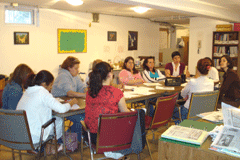
(Courtesy of Brazilian Women's Group)
ELTON: But along with those benefits, coop member Carla de Castro says, came some problems.
CASTRO: I felt a headache all day long and dizzy, and the end of the day you can’t smell anything because you just lost your sensitivity to smell. I can feel better if I stop to use. But I know if I continue to use for months and years, I know it’s going to make me feel very sick.
ELTON: Castro wasn’t the only one feeling this way. Monica Chianelli worked with immigrant activists, interviewing hundreds of Brazilian housecleaners. She heard many complaints like these and about respiratory problems, nose bleeds, fainting and skin rashes. Some of the women said they felt so bad they considered quitting the business.
So Chianelli and the activists started promoting green cleaning products. Their work caught the attention of epidemiologist David Gute of Tufts University. When he received a grant from the National Institute of Occupational Safety and Health to study immigrant occupational health issues, a chunk of it went to jumpstart the Vida Verde Cooperative.
GUTE: What we hope to get is a group of coop members who will take seriously the responsibilities of protecting their own health and also protecting, obviously, the environmental heath of the clients homes in which they work. I think that there will be a greater sense of control in their own lives and businesses as a result of this.
ELTON: Research shows there’s a higher incidence of asthma among professional cleaners as compared to other workers. And other studies examine indoor air pollutants that could affect human health. A four-year study recently completed at the University of California Berkeley looked at whether routine use of common cleaning products and air fresheners affect indoor air quality. Researchers studied solvents called glycol ethers – a toxic air contaminant and common ingredient in cleaning products. They also looked at other solvents called terpines. They’re the seemingly innocuous ingredients which give products lemon or pine scent. But terpines can create dangerous formaldehyde when they mix with ozone found in indoor air.
William Nazaroff was the lead scientist on the Berkeley study.
NAZAROFF: What we found was that the levels of exposure, both to glycol ethers and to secondary pollutants from terpine use, could be high enough to warrant further attention and some concern, especially under scenarios where high amounts of the products are being used in spaces that are small and not very well-ventilated.
ELTON: But Nazaroff is quick to point out there is still a lot that hasn’t been proven about the relationship between these toxic air contaminants and the health problems of housecleaners.
NAZAROFF: At this point we’re not able to connect the dots to say that the chemical exposures are, in fact, the reason that occupational asthma is elevated in this group. But more work is going to have to be done to try to fill in the gap between those two end points.
ELTON: And without that epidemiological data to prove a connection, Tufts’ David Gute says not much can be done to force a change in the formulations of the products.
GUTE: There has always been this uneasy tension in the regulatory community about when a chemical is safe to use. The prevailing wisdom has usually been that a chemical is safe until proven guilty. The vast majority of chemicals, either newly developed or new combinations, are not screened in any meaningful way prior to release.
ELTON: Vida Verde coop members aren’t the only ones unwilling to wait for science and government regulations to catch up with their concerns. The demand for natural home-cleaning products has taken off recently. And several states now require janitors clean schools and other public buildings with products that meet the standards of the nonprofit certifying company Green Seal. Currently, there is no certification standard for home cleaning products. But Green Seal expects to start certifying these products, too in the coming months.
Members of the Vida Verde Coop, however, opted for another approach.
[SOUND OF FILLING BOTTLES]
ELTON:On a recent morning, Monica Chianelli and another coop member make their own natural cleaning products. Members take turns and mix enough for others to use when they clean.
CHIANELLI: We made Amazing, now we are going to make Magic. Six cups of water and six cups of vinegar.

(Courtesy of Brazilian Women's Group)
ELTON: They use recycled plastic bottles to store the products, and put on Vida Verde labels to identify them. And then they’re ready to use them in their clients’ homes.
[SOUND OF MONICA CLEANING]
ELTON: In a large Victorian house outside of Boston, Monica Chianelli starts to clean in the kitchen.
CHIANELLI: First I used Fantastick that is a product we made with soap and borax. After that to rinse I use Amazing that is something with water and vinegar. Because vinegar dissolves the soapy films.
ELTON: Homeowner Katrin Kaufer says she is happy with the results.
KAUFER: I have young children. I’m glad that they are not exposed to any chemicals in the house. It’s good for our family and the environment as a whole. I don’t have any reason not to do it.
ELTON: Members of Vida Verde say that since they switched products their health problems have disappeared. And Coop members are hoping to convince more housecleaners to change the way they clean. They’re making presentations to housecleaners around Massachusetts to show them how to make their own natural products---and why.
For Living on Earth, I’m Catherine Elton in Boston.
[SOUND OF CLEANING AND SPRAYS]
Related links:
- Vida Verde Co-op group
- Press release on Tufts grant to address immigrant occupational risks
- Dr. William Nazaroff, University of California, Berkeley
Hung up on Hangers
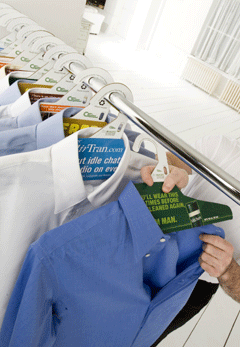
(Courtesy of Jaime Fraser)
CURWOOD: Advertisements, it seems, are almost everywhere, from the sides of buses to video screens in washrooms. They’re almost impossible to get away from. And now, marketer Bob Kantor is bringing them to just about the last ad-free frontier -- your bedroom closet. But Mr. Kantor says, it’s all in the interest of the earth. Old-fashioned wire clothes hangers consume almost 200 million pounds of steel a year in the U.S. alone.
And a good deal of that eventually ends up in landfills. So, Mr. Kantor says, he’s got the answer: the EcoHanger. It’s a hanger with an environmental—and oh, yes--a commercial—message.
KANTOR: EcoHangers are made out of recycled paper and are fully recyclable. They are a heavy-duty paperboard. It’s 34-ply paper, which is then folded twice and laminated like the back of a magazine. So, they’re a beautiful platform for distributing advertising and promotional messages that reach consumers in the mornings while they’re getting dressed.
CURWOOD: How exactly does your business model work?
KANTOR: The EcoHangers are distributed through a proprietary network of 35,000 drycleaners throughout the United States. That’s over 95 percent of the drycleaners in America. And we provide them to the drycleaners for free so it’s a win-win situation for the consumers, for the drycleaners, and for the marketers who want to reach consumers with their advertising.
CURWOOD: So, I get this hanger and it has an add on it. I wake up in the morning and I’m told I should buy, what?

(Courtesy of Jaime Fraser)
KANTOR: You wake up in the morning and instead of seeing the nasty mangled wire hangers that typically sit in your closet you see a beautiful message in 4 color that’s targeted directly to you from marketers who want to reach adult men and/or women during their dressing and grooming ritual.
CURWOOD: Okay, so let’s say I’m in Chicago and I want to advertise in that market. How much is it going to cost me? For every hanger that’s got the Steve Curwood Shirt Company on it, what do I have to pay?
KANTOR: It depends on how many people are in the individual buys, but on a cost per impression, which is the way advertisers tend to compare media it’s anywhere from between four and five cents. So it’s a very efficient media buy.
CURWOOD: How much steel do you think your business is eliminating now from the U.S. market per year, today?
KANTOR: It’s hard to put an estimate on it because our business has been growing at a pretty rapid pace, but we are on pace to virtually eliminate all wire hangers in the United States that are used on shirts delivered through drycleaners.
CURWOOD: There’s only one thing, Bob, about this. What if the muffler is falling off of my car? How am I going to use your hanger to wire it up?
KANTOR: Virtually the only reason that anyone would ever want to have a wire hanger again is to either keep your muffler on or break into your car.
CURWOOD: Bob Kantor is the CEO of Hanger Network. It’s a company that makes clothes hangers out of recycled material. Thank you so much sir.
KANTOR: My pleasure.
CURWOOD: Of course there is another way to reduce steel waste and still keep your closet ad-free. Just take your old hangers back with you to the cleaners and ask them to use them again.
Related link:
Hanger Network website
[MUSIC: Landing “From Above” from ‘Mind Expansion Compilation’ (Mind Expansion – 2007)]
CURWOOD: You can catch our show anytime, or download a podcast, at our Web site—LOE.org. That's LOE.org. And we’d love to hear your comments.
The address is comments@loe.org. Once again, comments@loe.org.
The number for our listener line is 800-218-9988. And the mail carrier will bring us your old-fashioned letters at 20 Holland Street, Somerville, Massachusetts, 02144, U.S.A.
CURWOOD: Coming up, The Largest Movement in the World that You've Never Heard About. Stay tuned to Living on Earth.
ANNOUNCER: Support for the Environmental Health Desk at Living on Earth comes from the Cedar Tree Foundation. Support also comes from the Richard and Rhoda Goldman Fund for coverage of population and the environment. This is Living on Earth on PRI, Public Radio International.
Colorado Plateau Drilling Plan
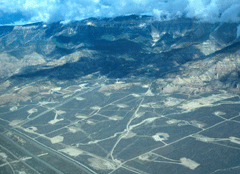
Gas development on public and private lands is already underway at the base of the Roan Cliffs. The BLM's decision would open up the undeveloped land on the plateau for additional drilling. (Courtesy Colorado Environmental Coalition, 2003)
CURWOOD: It’s Living on Earth. I’m Steve Curwood. In the Rocky Mountains hunting and conservation groups have been fighting hard to protect what they consider sensitive terrain from the natural gas drilling boom with all its roads, pipelines and wellheads. And it looks like they have lost a battle: the federal agency that oversees Colorado’s Roan Plateau says the drill-rigs may now enter. Living On Earth’s Ingrid Lobet reports.
LOBET: North of interstate 70 in western Colorado, steep cliffs rise and then flatten onto the Roan Plateau, and its forests, native trout streams and colored canyons. Marc Smith of the Independent Petroleum Association of Mountain States knows the area by a different name: the Naval Oil Shale Reserves 1 and 3.

Gas development on public and private lands is already underway at the base of the Roan Cliffs. The BLM's decision would open up the undeveloped land on the plateau for additional drilling.
(Courtesy of Colorado Environmental Coalition (2003))
LOBET: Energy companies that lay the pipe, set drill rigs and build roads have pressed to get into this area, because the reserves underneath are so rich.
SMITH: The Naval Oil Shale Reserves 1 and 3 hold enough natural gas to heat four million homes for 20 years. Some nine trillion cubic feet of fuel.
LOBET: Now after years of controversy, the Bureau of Land Management has decided to open up about half the public land on top of the plateau to gas drilling.
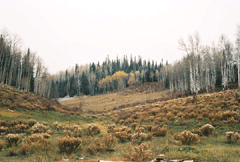
Aspen trees and old-growth Douglas Firs make up a lot of the forest land on the plateau.(Courtesy of the Bureau of Land Management)
BASTABLE: I just can’t express the values that are up there and the values that are at stake with this.
LOBET: Clare Bastable has spent weeks camping on the plateau. She’s with the Colorado Mountain Club, one of many hunting, fishing, conservation and recreation groups banded together in the campaign for the Roan Plateau.
BASTABLE: It’s one of the central locations for mule dear and other big game populations and so it’s really a haven for wildlife. It’s just got such an incredible diversity in its landscape from kind of rolling hills, to spruce and fir, and aspen forests to deep canyons that have been likened to Yosemite.
LOBET: Below the plateau there are thousands of new gas wells on both public and private land. In Garfield County alone, were much of the plateau sits, 1700 new wells were approved last year.

The plateau is home to elk, mountain lion, golden eagles and the Columbian Sharp-tailed grouse. (Photo:Ingrid Lobet (2005))
BASTABLE: Not every landscape, every last landscape, needs to be drilled and the Roan falls under one of these landscapes that we feel needs to be protected.
LOBET: Some maintain that even under the new plan, it will be. BLM has included what all agree are some new safeguards. Energy companies will only be allowed to tear up 350 acres of pipeline path or drilling area at a time. Then they’ll have to replant that scraped earth with native plants before moving on to the next ridge top.
Rural Garfield County stands to gain some 57 million dollars a year under the BLM’s lease plan. Nevertheless, public sentiment in this part of the country has been shifting toward more environmental protection as gas wells proliferate. The new governor of Colorado, Bill Ritter, was not happy when the BLM issued the plan and refused to give him more time to weigh in on something that had been approved by the prior Republican governor. Spokesman Evan Dreyer.
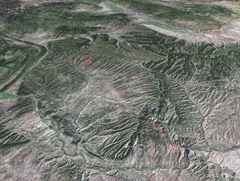
Computer generated, panoramic aerial view of the Roan Plateau. (Photo: Dr. William Bowen. California Geographical Survey)
DREYER: Those two actions deny what is a new administration ample time to review what is a very significant public policy matter that concerns the entire state of Colorado.
LOBET: Now Governor Ritter is backing a more adversarial effort by two Colorado congressmen and a senator to slow down the project by blocking money for it in Congress. Again, Evan Dreyer.
DREYER: Well, the BLM says that its decisions are based on directives from Congress, so we are seeking through legislation, Congressional legislation what we had asked for administratively—additional time.
LOBET: If that effort fails and no judge issues a stay, bidding would soon begin for the right to drill in this sought-after corner of the Rockies.
For Living on Earth, I’m Ingrid Lobet.
[MUSIC: Shearwater “I Can’t Wait” from “Waterloo Records 25th Anniversary’ (Waterloo Records – 2007)]
Related links:
- Independent Petroleum Association of Mountain States site
- The citizen advocacy group Save Roan Plateau
- Bureau of Land Management Roan Plateau site
[MUSIC: Unknown Male Inuit Singer “Survivor’s Song” from ‘Songs of the Inuit’ (Victor Entertainment – 1994)]
A Whale of a Sliver

This harpoon tip discovered inside a recently killed bowhead whale was probably fired into the animal around 115 years ago by an Inuit hunting party. (Courtesy New Bedford Whaling Museum)
[SOUND OF BOWHEAD WHALE SPOUTS AND SONG]
CURWOOD: Sometime in the late 1800s, probably around 1890 or so, a male bowhead whale swimming in the Arctic waters off Alaska encountered a band of Eskimo hunters.
One of the hunters fired a harpoon, hitting the whale in the neck. But the bowhead didn’t die and continued to swim the waters of the Arctic for about another 115 years. We know this because in May another band of Eskimo hunters killed the whale. And when the hunters carved up its 49-foot carcass, they found a piece of metal embedded in its neck.
BOCKSTOCE: It's a piece of brass about 3.5-4 inches long.

This harpoon tip discovered inside a recently killed bowhead whale was probably fired into the animal around 115 years ago by an Inuit hunting party.(Courtesy New Bedford Whaling Museum)
BOCKSTOCE: We examined the piece and found that it was a model made after a patent of 1879 which was only made from 1879 to 1885, we think. It would have had to be shipped to San Francisco, where the whaling fleet was based in those days, and carried to northern Alaska. So, 1890 seems to be a reasonable estimate of when it was used. Either earlier or later by a few years perhaps.
CURWOOD: So this find provides direct evidence for how long whales can live. Scientists usually use a rather obscure method to calculate the age of whales—they analyze amino acids in whales’ eyes. And they’ve concluded that some whales can live as long as 200 years. But the explosive spear tip found in this whale provides much clearer evidence of its age.

This type of harpoon was manufactured in New Bedford toward the end of the 1800s. It featured an exploding lance head that would detonate once it embedded itself in the whale hunter's prey. (Courtesy New Bedford Whaling Museum)
CURWOOD: And consider this--It is possible the hunters who killed the ancient bowhead in May could be descended from the very same hunters who first attacked it more than a century ago. John Bockstoce says he found tiny scratches on the spearhead.
BOCKSTOCE: And that we think is an ownership mark that a native whaleman would have used. Because the Eskimos who have hunted whales for at least 2000 years up there for their subsistence, they mark their hunting equipment with their own particular brand. This has six little notches and we don't know who that person was, but it is definitely is unlike something that would have been done by say, a commercial whaleman at the same time.
CURWOOD: A century ago the whales were being hunted to the edge of extinction. Today, bowheads have rebounded, and though commercial whale hunting is generally illegal, Eskimos are still allowed under an international treaty to kill roughly 50 whales a year.
Blessedly Unrestful
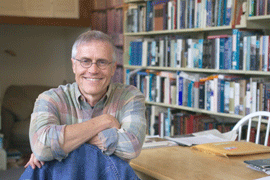
(Courtesy of Viking Press)
CURWOOD: In his 40 years as a businessman, writer and environmental innovator, Paul Hawken has worked and spoken with hundreds of small, nonprofit organizations. These are groups that work on everything from sustainable business practices to urban planning, to rainforest protection to prison reform. They span a remarkable and growing spectrum of causes and concerns and after a while, it became apparent to Paul Hawken that these groups are actually all part of one global, decentralized movement. He says it is arising in response to the downsides of industrialization and globalization. After ten years of research on these groups and the growing links among them, Paul Hawken has written a book entitled “Blessed Unrest: How the Largest Movement in the World Came into Being and Why No One Saw It Coming.” He says it’s drawing together groups focused on such broad, but often separate themes as the environment, social justice and the rights of indigenous peoples.
HAWKEN: They are seen as separate in many ways. Their activities are very specific but in fact they are realizing, as I think many of us are, that in order to be effective in the areas in which they concentrate, they have to work as a system. They have to collaborate and they have to communicate with each other.
CURWOOD: So, how is this different from say previous social movements, like abolition or suffrage, or the environmental movement?
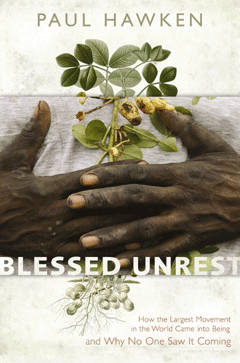
Hawken's newest book, "Blessed Unrest"
(Courtesy of Viking Press)
HAWKEN: Most movements, first of all, are created because there’s an imbalance of power and it tries to aggregate that power to itself. And this movement is trying to disperse the pathological concentrations of power because it sees that as one of the main causes of the things it’s addressing. Second of all, movements usually arise because there’s a charismatic leader. And that leader then gathers people around him or her and then a movement grows and morphs outwards. But this movement is truly a bottom up movement. And the third reason it’s different, is because it doesn’t really know it’s a movement. That is to say it didn’t organize itself originally to be a concentration of power. It has no centrality. And what you’re seeing now due to modern-day technologies—the internet, texting, cell phones—is that this huge, at one-time inchoate, movement is starting to hook-up and collaborate and become more powerful.
CURWOOD: Now, poverty has a huge impact on the health of the environment. And yet many of the best-funded environmental groups tend to think first of habitat preservation and maybe second of reducing poverty. You argue that the separation between human rights and the environmental movement is really a false split. Can you explain that please?
HAWKEN: I will in several ways. First of all, we include indigenous movements, and I think they’re critical in two ways. One because they are the custodians and stewards of the last great remaining stands of timber and minerals, and water, and the earth. They are being now sort of confronted by corporate interests all over the world and so their guardianship is critical to the survival of this planet. Second, because indigenous groups never disaggregated the concept of social justice and the environment. It’s a concept that doesn’t even occur to them that injustice to one is injustice to the other. I think the way I see it is that we in the West definitely have seen them as separate. But from my point of view the fact is that we have a political economic system that’s stealing from the future and selling then it in the present as GDP or as a profit. And whether you steal that in the form of a clear-cut forest in British Columbia, or whether you steal it in the form of exploitation of child workers, or whether it’s a toxic factory in China, you’re doing exactly the same thing. That is to say you’re foreclosing the future for people by destroying either a place or people themselves.
CURWOOD: Now, you’re a businessman. I believe you started in Boston with an organic grocery store and Smith and Hawken’s, a well-known garden tool company. And it sounds like you think business is the problem here.
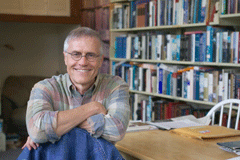
Author Paul Hawken (Courtesy of Paul Hawken)
HAWKEN: Business has always been the problem. It’s been the problem since the conquest and it’s gotten worse and worse, and worse. And at the same time there are many, many businesses who are organizing themselves to address these problems. This is not solvable without business and government. I do not mean to imply, by focusing on civil society, that somehow it’s going to save the day. Really, what I’m saying here, this is not a movement that’s trying to aggregate power. This is a movement that’s trying to suffuse the institutions of the world with new ways of thinking, new ways of doing things, new ways of being. So therefore its effectiveness, and in the end looking back, its power if you will, will be measured by how much it changes other institutions, and business is certainly one of those important institutions.
CURWOOD: At one point in your book, Paul, you argue that globalization of commerce and trade is pushing communities around the world into a homogenous culture of consumption. There’s a Nike sneaker on every foot. There’s a can of Coca-Cola in every hand. How is this movement you describe responding to this spread of commodity culture?
HAWKEN: I think one of the great responses to it is you’re seeing it in localization of economies. You’re seeing it in the slow food movement, which is very much about farming and culture. And you’re seeing it as an expression and a need for people to create resilience in their own communities. You know this post-carbon movement. This idea that a locale should be more interdependent with respect to fuel, energy, food, transportation. And in the process, it is rediscovering its own cultural, biological, culinary roots. And you’re starting to see people reassemble things that they have lost. And this is true all over the world. Globalization has created this sense of loss that went so far and has gone so far that I think you’re starting to see it come back. And it’s being driven very, very much by the threats that peak oil pose. But there’s not just peak oil, there’s peak soil, there’s peak water. There’s a lot of peaks coming and they’re all related. And so people are starting to you know to sniff the wind, feel it and starting to create again, alternatives to this in their communities.
CURWOOD: Paul Hawken, you’re not afraid of big ideas and you advance one in this book based on the Gaia hypothesis, that is that the earth is really one living organism. And you say just like living organisms have an immune system, this social reaction to what’s happening with to the environmental degradation of the planet is being responded to by us as a body would respond to an infection.
HAWKEN: Well, many scientists and philosophers have speculated for centuries that humanity itself acts like an organism. No one’s been able to prove this or disprove it. It’s just simply something that observationally seems to be evident and true. I am building on that and saying what I believe is the only reasonable explanation to describe and justify what you see arising, since it doesn’t have a source as some other agent. So I turn to biological metaphors and I turn to the immune system because the immune system is the most complex system in the body by far. Our idea of the immune system is that it’s like the department of defense and it kills invaders, and it certainly can do that. But long before it does that, it’s like a big chamber of commerce mixer, where everybody is meeting eachother, including pathogens. And it tries détente and rapprochement before it tries death. So if we understand that there is within us individually this ability, why not as community? We are a community of cells. There is no such thing as a single cell in the sense of how it acts. It acts in community. We act in community. And because of communication, because of globalization, because of technology there’s no reason that we can’t imagine that we in some collective way are now acting as communities and evincing characteristics and responses that make total sense from a biological point of view, which is that we want to persist. We want to create a durable living economy. We want to restore some semblance of grace and justice, and beauty to our lives and those that follow us. And I feel that this movement is that expression. This movement, that may never have a name but is growing more powerfully and more quickly than anything else on earth.
CURWOOD: Paul Hawken’s latest book is called “Blessed Unrest: How the Largest Movement in the World Came into Being and Why No One Saw it Coming.” Thank, you Paul.
HAWKEN: Thank you, Steve.
[MUSIC: Max Richter “Organum” from ‘The Blue Notebooks’ (Fat Cat Records – 2004)]
CURWOOD: And you can hear more of our interview with Paul Hawken on our Web site, LOE.org.
[MUSIC UP AND UNDER]
Related links:
- Hawken's website, Wiser Earth connects social activist networks around the world
- To hear a longer interview with Paul Hawken click here
CURWOOD: Next time on Living on Earth: Frogs are disappearing from ecosystems around the world. But in Utah, a river restoration project is helping frogs bounce back.
TRATER: I think if this project hadn’t had come on line, if it would have been going the way it was before, another generation they wouldn’t even know they had ever even existed. I mean a world without frogs, it’s a sad world. And if you don’t know it then you don’t know what you are missing.
CURWOOD: The return of the Columbia spotted frog next time on Living on Earth.
[MUSIC UP AND UNDER]
CURWOOD: Living on Earth is produced by the World Media Foundation. Our crew includes Ashley Ahearn, Eileen Bolinsky, Bruce Gellerman, Ian Gray, Ingrid Lobet, Andrea Smardon, Peter Thomson and Jeff Young - with help from Jeff Turton, Bobby Bascomb, and Kelley Cronin. Our interns are Lauren Cox and Amy Fish. Dennis Foley is our technical director. Today, we bid a fond farewell to our development associate Jennifer Percy. Thanks, Jen. Alison Lirish Dean composed our theme. You can find us anytime at L-O-E dot org. I’m Steve Curwood. From all of us here at Living on Earth, thanks for listening.
ANNOUNCER: Funding for Living on Earth comes from the National Science Foundation, supporting coverage of emerging science; And Stonyfield Farm Organic yogurt and smoothies. Stonyfield pays its farmers not to use artificial growth hormones on their cows. Details at Stonyfield dot com.
Support also comes from you our listeners, the Ford Foundation, the Wellborn Ecology Fund, and Pax World Mutual Funds—socially and environmentally sustainable investing. Pax World, for tomorrow. On the Web at paxworld dot com.
Living on Earth wants to hear from you!
Living on Earth
62 Calef Highway, Suite 212
Lee, NH 03861
Telephone: 617-287-4121
E-mail: comments@loe.org
Newsletter [Click here]
Donate to Living on Earth!
Living on Earth is an independent media program and relies entirely on contributions from listeners and institutions supporting public service. Please donate now to preserve an independent environmental voice.
NewsletterLiving on Earth offers a weekly delivery of the show's rundown to your mailbox. Sign up for our newsletter today!
 Sailors For The Sea: Be the change you want to sea.
Sailors For The Sea: Be the change you want to sea.
 The Grantham Foundation for the Protection of the Environment: Committed to protecting and improving the health of the global environment.
The Grantham Foundation for the Protection of the Environment: Committed to protecting and improving the health of the global environment.
 Contribute to Living on Earth and receive, as our gift to you, an archival print of one of Mark Seth Lender's extraordinary wildlife photographs. Follow the link to see Mark's current collection of photographs.
Contribute to Living on Earth and receive, as our gift to you, an archival print of one of Mark Seth Lender's extraordinary wildlife photographs. Follow the link to see Mark's current collection of photographs.
 Buy a signed copy of Mark Seth Lender's book Smeagull the Seagull & support Living on Earth
Buy a signed copy of Mark Seth Lender's book Smeagull the Seagull & support Living on Earth

